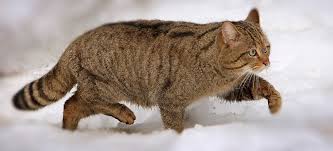 After 150 years there resurface wild cats in the Low Countries.
After 150 years there resurface wild cats in the Low Countries.
In Belgium, the species was still in the Ardennes. In October 2012 she was filmed in the nature park Smeetshof in Limburg Bocholt (where an otter has been spotted.) Camera traps photographed in the spring 2013 a wild cat in the forests of the Voer region.
The domestic cat (Felis catus) which everyone knows is a descendant of the African Wild Cat. The European wildcat (Felis silvestris silvestris) is a close relative and a subspecies of the wild cat (Felis silvestris). Rarely appear (normally sterile) hybrids or mongrels.
The European wild cat is very shy and resembles a large, strong common cat. She never has spots, just black gray tiger stripes. The main feature is the thick tail with three to five broad, dark rings which forwards are getting paler. The tail is rounded and black. The eyes are pale yellow.
The dark stripe down its back (dorsal stripe) begins behind the shoulders and goes to the tail start (not the tip). The dorsal stripe is not connected to the dark side stripes. They have often, but not always a white spot on the chest.
The nose (front pad of the nose) is flesh colored.
Feral cats have a body length of 48 to 68 cm and a tail length of 21 to 38.5 cm. They weigh 1.6 to 8 kg and have a shoulder height of 35 to 40 cm. Males are larger than females.
They hunt rabbits and small rodents, birds, amphibians, fish, insects and young ungulates (lambs and fawns), and also eat grass.
A hollow tree, a crevice between rocks, deserted rabbit or badgers burrows are used as a hole in the cold period between November and February.
Given European wild cats are easily confused with stray cats, they also got shot by mistake.
